Monthly economic brief: January 2022
The monthly economic brief provides a summary of latest key economic statistics, forecasts and analysis on the Scottish economy.
This document is part of a collection
Consumption
Consumer sentiment weakened in Q4 2021, particularly in December, however the composite index remains significantly higher than at the start of the year.
Consumer sentiment
- Consumer sentiment indicators continue to be highly sensitive to the rapidly moving developments on the pandemic and the unprecedented economic challenges that have occurred during its initial stages and over the course of the recovery to date.
- In December, consumer sentiment in Scotland weakened over the month, with the Scottish Consumer Sentiment Indicator falling 3.4 points to 3.4, its lowest level since May 2021.[19],[20] Consumer sentiment generally softened over the fourth quarter of 2021, however overall remains positive and notably improved from the series low levels of sentiment in the second half of 2020.
Scottish Consumer Sentiment Indicator 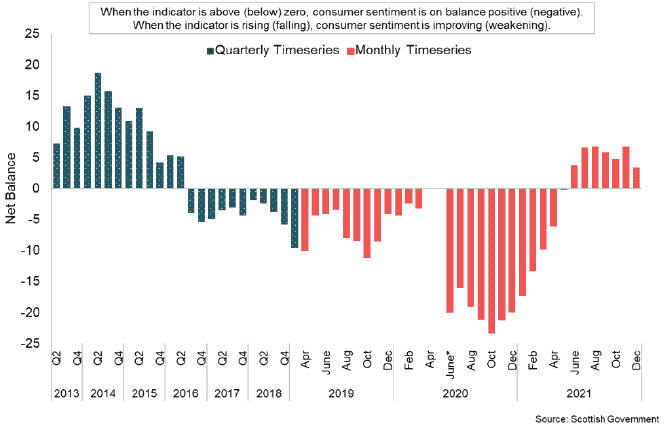
- The fall in sentiment in December was driven by a weakening in current sentiment and expectations about economic performance and household finances. Households continue to expect the Scottish economy and household finances to improve over the coming year, however the indicator net balances fell to their lowest levels since the start of 2021.
- Despite the weakening in sentiment across the other indicators, the household spending indicator was unchanged over the month, however remained in negative territory reflecting that households on balance felt less relaxed about spending money than they did last year.
Retail Sales
- In December 2021, retail sales in Great Britain fell by 3.7% on November as the volume of retail sales further moderated from earlier in the year, however remained 2.6% higher than their pre-pandemic level in February 2020.[21]
- Non-food stores sales fell by 7.1% in December following a pick-up over October and November with retailers noting that the Omicron variant had impacted footfall. Food store sales also fell in December (-1%), however remained 2.0% above their pre-pandemic level.
GB Retail Sales Index 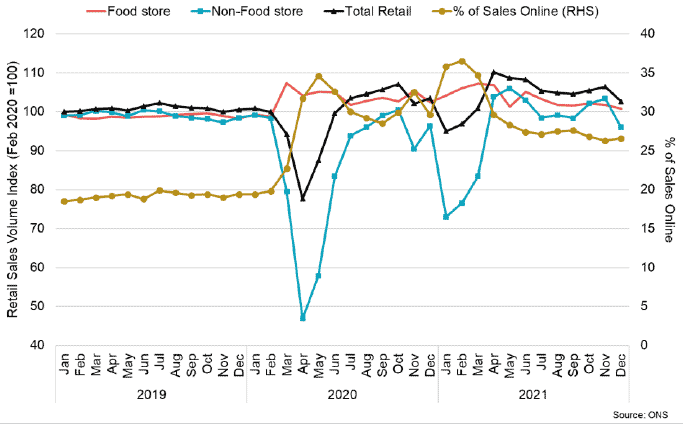
- On a monthly basis, the proportion of retail sales online rose to 26.6% in December (up from 26.3% in November) and remained significantly higher than in February 2020 prior to the pandemic (19.7%).
Household Savings and Consumer Credit
- At an aggregate level, households have increased their levels of savings during the pandemic due to a reduction in expenditure coupled with a rise in disposable income through the retention of earnings. This was particularly evident during periods of lockdown in Q2 2020 and Q1 2021 when consumer facing services were largely closed.
- Bank of England data provides insights at an aggregate level of how savings and consumer credit flows have evolved over the year as restrictions have been removed and economic activity recovery has progressed.
- At an aggregate level, net flows from UK households into deposit-like accounts was £4.5 billion over the month in November 2021.[22] This continued its downward trend from recent months during which the average monthly net flow into banks and building societies and national savings and investment accounts was £11.2 billion in the year to October 2021, and was slightly lower than pre-pandemic flows which averaged £5.5 billion in the year to February 2020.
Net flow of household deposits 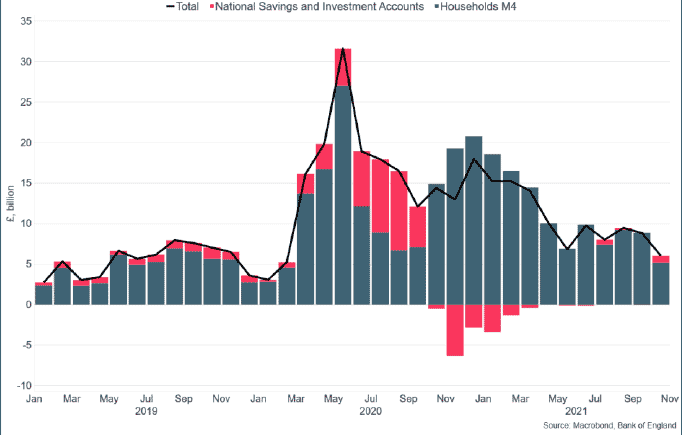
- Alongside this, net consumer credit fell significantly during the pandemic, however started to grow again over the course of 2021. In November, consumers borrowed £1.2 billion in credit on net. Within this, they borrowed £0.9 billion in credit card debt and £0.4 billion of ‘other’ forms of consumer credit (such as card dealership finance and personal loans). November was the ninth consecutive month of positive net borrowing and the highest since July 2020.
Net Consumer Credit per month 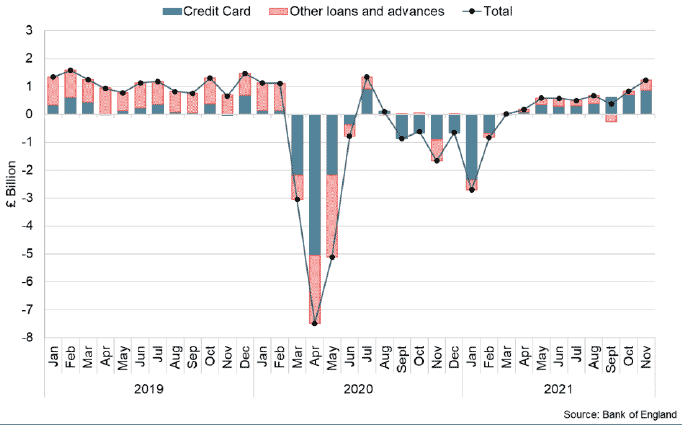
Inflation
- UK CPI inflation was 5.4% in December, up from 5.1% in November, and has risen to its highest rate since the 1990s.[23] Inflation rates also continued to rise in the US (7.1%) and in the Eurozone (5.0%), in part reflecting rising energy prices over the past year.
UK CPI inflation – Rate and Contribution 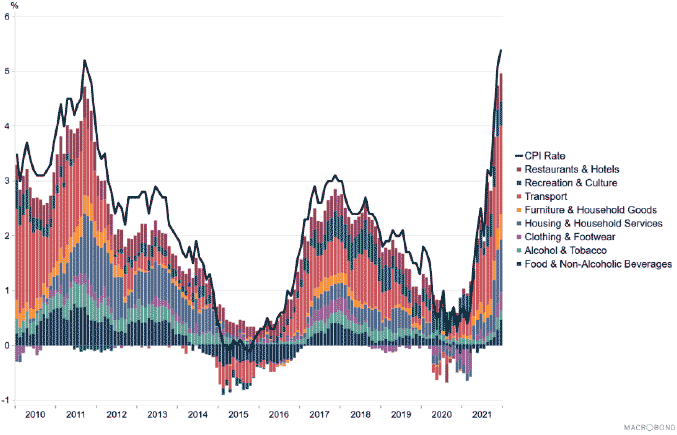
- UK inflation continued to rise, as forecast, in part reflecting the broad based increase in prices across goods and services, particularly in fuel and energy costs for transport and housing, and in the latest month the cost of food.
- Further price rises are expected, with the Bank of England forecasting inflation to peak at around 6% in the first half of 2022, and cost of living challenges continuing to intensify.
- Similarly, producer price inflation (changes in the prices of goods bought and sold by UK manufacturers, including price indices of materials and fuels purchased and factory gate prices) also remained elevated in December, though had softened slightly from November.
- Input price inflation was 13.5% in December (down from 15.2% in November) while output price inflation was 9.3% (down from 9.4% in November).[24]
UK Producer Price Inflation 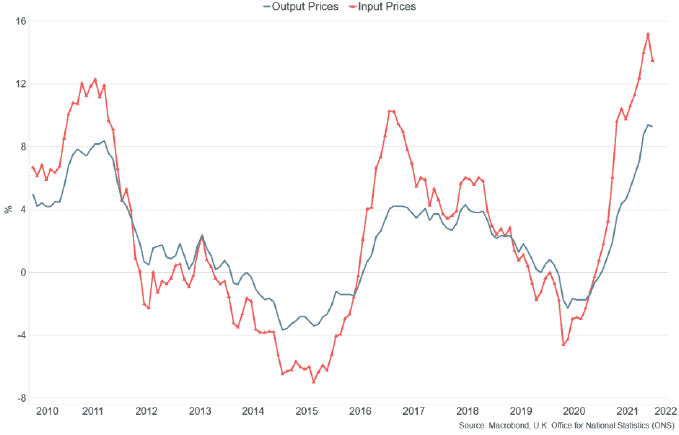
- In response to the further rise in underlying inflationary pressures, at their December meeting, the Bank of England’s Monetary Policy Committee (MPC) increased the Bank Rate by 0.15 percentage points to 0.25%, with no change to the current programme of Quantitative easing.[25]
- The MPC noted that inflation in advanced economies has risen by more than expected in their November Monetary Policy Report and there are some signs of greater persistence in domestic cost and price pressures. In terms of the potential impact of Omicron, the MPC considered that it presents downside risks to economic activity in the short term, however, the medium term impacts on inflationary pressures remained unclear.
Contact
Email: OCEABusiness@gov.scot
There is a problem
Thanks for your feedback